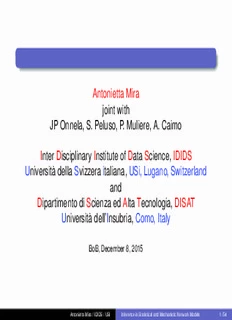
Keynote Antonietta Mira PDF
Preview Keynote Antonietta Mira
Antonietta Mira joint with JP Onnela, S. Peluso, P. Muliere, A. Caimo Inter Disciplinary Institute of Data Science, IDIDS Università della Svizzera italiana, USi, Lugano, Switzerland and Dipartimento di Scienza ed Alta Tecnologia, DISAT Università dell’Insubria, Como, Italy BoB,December8,2015 AntoniettaMira/IDIDS/USI InferenceinStatisticalandMechanisticNetworkModels 1/54 Summary Inference in Statistical and Mechanistic Network Models • InferenceforMechanisticNetworkModels(JPOnnela) NOLHD • InferenceforStatisticalNetworkModels(S.Peluso+P.Muliere) AVAILABLELHD • InferenceforIntractableNetworkModelsviaMCMC(A.Caimo) INTRACTABLELHD AntoniettaMira/IDIDS/USI InferenceinStatisticalandMechanisticNetworkModels 2/54 Motivation • Systemsofscientificandsocietalinteresthavelargenumbersofinteracting components • Representationasnetworks:node=component,edge=interaction • E.G.:Friendship/Advisorynetwork,Citationnetwork,Webpagelinknetwork • Networkmodelsusedtostudy: • Socialandcontactnetworks:spreadofpathogens,behaviorsandinformation • Biologicalnetworks:generegulation,signaltransduction,proteininteraction AntoniettaMira/IDIDS/USI InferenceinStatisticalandMechanisticNetworkModels 3/54 Network Models • Distinctionbetweenmodelsoftwothings: • Modelsofnetworkstructure(e.g,Erdo˝s-Rényi) • Modelsofdynamicalprocessesonnetworks(e.g.,SImodel) • Whycareaboutnetworkstructure? • Interplaybetweennetworkstructureandthebehaviorofdynamical processesonnetworks(e.g.,hubsinepidemics) • Modelsofnetworkstructureareusefulforunderstandinghownetworked structuresarise • Modelsareoftenidealizedandnotintendedtoberealistic AntoniettaMira/IDIDS/USI InferenceinStatisticalandMechanisticNetworkModels 4/54 Network Models Distinctionbetweentwotypesofmodelsofnetworkstructure: • Statisticalmodels(e.g.,ERGM,Goyal-Blitzstein-DeGruttola) DATADRIVEN • Pros:inferenceonmodelparameters;hypothesistesting;modelfitting • Cons:scalability;hardtoincorporatedomainknowledge • Mechanisticmodels(e.g.,Pricemodel&Barabási-Albertmodel) KNOWLEDGEDRIVEN assumethatmicroscopicmechanismsthatgovernnetworkformationand evolutionareknown,askwhathappensifweapplythesemechanismsrepeatedly • Pros:easytoincorporatedomainknowledge,scalability • Cons:noinferentialtools;nomodelcomparison AntoniettaMira/IDIDS/USI InferenceinStatisticalandMechanisticNetworkModels 5/54 Big Data • Technologygeneratesnewtypesofdataandnewmodelingchallenges Figure:Snowballsampleofamobilephonecommunicationnetworkof7millionnodesand23 millionties.Adaptedfrom:Onnelaetal.PNAS104,7332(2007). AntoniettaMira/IDIDS/USI InferenceinStatisticalandMechanisticNetworkModels 6/54 Mechanistic Model of Weighted Social and Contact Networks • Simplemechanisticmodelofsocial/contactnetworks(weighted) Fromtheperspectiveoftimeexpenditure: • spendtimewithexistingfriends(a)/newfriends(b,c) • Twomechanismsforformingties(b,c) • Tiestrengthmatters:choiceofinteractionpartners&reinforcementofties • Somemechanisticmodelsareanalyticallytractable,butsimulationenables considerationofamuchbroaderclassofmodels • Onestrengthofamechanisticmodelinthatyoucanmakecausalinferences AntoniettaMira/IDIDS/USI InferenceinStatisticalandMechanisticNetworkModels 7/54 Mechanistic Model of Weighted Social and Contact Networks AntoniettaMira/IDIDS/USI InferenceinStatisticalandMechanisticNetworkModels 8/54 Approximate Bayesian Computation (ABC) StartingpointisBayes’theorem: p(D|θ)p(θ) p(θ|D)= p(D) • p(θ|D)=posterior • p(D|θ)=likelihood • p(θ)=prior • p(D)=evidence(akamarginalLHD,priorpredictiveprobabilityofthedata) EvaluationoftheLHDmaybecomputationallyexpensiveorinfeasible,rulingoutboth likelihood-basedandposterior-basedinference ApproximateBayesianComputation(ABC)avoidsdirectevaluationoftheLHDand approximatesitbygeneratingsyntheticdata(syntheticobservations)bydirect simulationfromthemodel SunnakerMetal.ApproximateBayesiancomputation.PLoSComputBiol9.1(2013):e1002803. AntoniettaMira/IDIDS/USI InferenceinStatisticalandMechanisticNetworkModels 9/54 Approximate Bayesian Computation (ABC) • ABCrejectionsampleristhesimplestformofABC ABCrejectionsampler • Sampleparameterθ∗fromthepriorp(θ) • SimulatedatasetD∗underthegivenmodelspecifiedbyθ∗ • Acceptθ∗ifρ(D∗,D)≤(cid:15) • Distancemeasureρ(D∗,D)determinesthelevelofdiscrepancybetweenthe simulateddataD∗andtheobserveddataD • Theacceptedθ∗areapproximatelydistributedaccordingtothedesiredposterior and,crucially,obtainedwithouttheneedofexplicitlyevaluatingtheLHD AntoniettaMira/IDIDS/USI InferenceinStatisticalandMechanisticNetworkModels 10/54
Description: